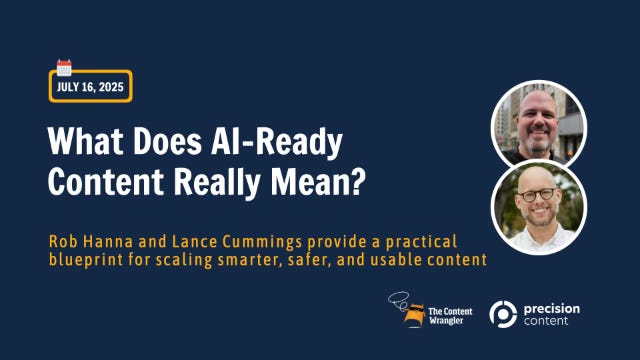What is AI-Ready Content?
Creating content for both humans and machine minds
🔴 Live July 16, 11am EDT: Join me and Rob Hanna for "What Does AI-Ready Content Really Mean?" - a free webinar showing how Information Typing creates content that works for both humans and AI. Register here
Ever wonder why some content works with AI and some doesn’t? It sometimes seems so random …
Maybe it needs to be more “AI-ready.”
AI-ready content is information organized to match the natural thinking patterns that both humans and machines use to process and act on information.
Rather than dumping everything into undifferentiated paragraphs, you explicitly structure content around cognitive functions, or what users need to:
know (reference facts)
understand (grasp concepts)
follow (adhere to principles)
see working (understand processes), or
do (complete tasks).
This approach eases information overwhelm by parsing content into digestible cognitive chunks that align with how minds—biological and artificial—naturally categorize and retrieve information.
When a human scans for actionable steps, they can jump straight to task-oriented sections. When an AI needs to distinguish between factual data and procedural instructions, the cognitive architecture is already there.
After spending the week converting parts of my study abroad faculty guide using this approach (or content base for an AI chatbot), I can show you exactly what this transformation looks like and why it creates content that performs better for both human readers and AI applications.
The Problem with Unstructured Thinking
Here's how I originally described a visit to Krakus Mound in Kraków:
"A visit to Krakus mound shows students a space few tourists experience and that is beloved by the locals, also providing an opportunity to enjoy some green space and bond as a group. I usually schedule this impromptu … when it feels right and the weather is good. Take the tram or scooters to the cemetery stop, then find the cemetery path up."
This reads fine to humans who can parse context and infer meaning. (Probably not exciting to read, though, and even harder to use.)
Information Typing creates a shared cognitive architecture that both humans and AI can navigate effectively.
AI can probably parse this at a small scale, but I as I add more entries, that’s likely to be come more difficult. There is also missing information that any chatbot is likely to just make up to fill in the gaps.
Information Typing: The Missing Piece
The breakthrough comes from applying Information Typing, a methodology that separates content based on cognitive function rather than just format. Instead of generic "content," you explicitly label information by what users need to do with it:
Reference: Facts users need to know
Concept: Ideas users need to understand
Principle: Guidelines users must follow
Process: How systems work (who does what)
Task: Step-by-step instructions for achieving goals
When I restructured that same Krakus Mound information using these types, something remarkable happened. The messy paragraph became a clear, purposeful structure:
Educational purposes and learning objectives [CONCEPT]: "This visit introduces students to Poland's pre-Christian heritage while providing cultural immersion through a local tradition..."
Organize a Krakus Mound visit [TASK]: "Complete these preparation steps before departing for Krakus Mound: 1. Check weather forecast and sunset timing 2. Confirm transportation method..."
Faculty guidelines for visits [PRINCIPLE]: "Schedule this visit when weather conditions are favorable and sunset viewing is possible..."
Why This Matters for AI Performance
When content is properly typed by cognitive function, AI systems can understand not just what information exists, but how that information should be used.
This dramatically improves retrieval accuracy and reduces hallucinations because the AI isn't guessing about the purpose of each piece of content.
More importantly, the same structure that helps AI also helps humans. Students scanning for practical logistics can jump straight to the TASK sections. Faculty planning curriculum can focus on the PRINCIPLE blocks.
Everyone benefits from the cognitive clarity.
The Bigger Picture
This example represents something larger happening in content strategy. We're moving beyond the old choice between "content for humans" versus "content for machines."
Information Typing creates a shared cognitive architecture that both humans and AI can navigate effectively.
When you explicitly structure content around how people think and process information, you're not just organizing words on a page. You're designing content that preserves intent, improves accuracy, and scales across both human readers and AI systems.
What's Next
On July 16th, I'm joining Rob Hanna from Precision Content for a live webinar where we'll dig deeper into what it means for content to be “AI-Ready.”
What Does AI-Ready Content Really Mean?
July 16, 2025, 11:00am EDT
Free registration includes access to the recording
This is the first in a series of deep dives I'm planning on structured content and AI performance. After the webinar, I'll be exploring how these principles apply to prompt libraries, knowledge base design, and automated content generation.
The goal is always the same: content that works better for everyone.
Can't make the live session? Register anyway—we'll send you the recording. This 60-minute session is brought to you by The Content Wrangler and sponsored by Precision Content.
What questions do you have about structuring content for AI? Reply and let me know what you'd like to see in future posts in this series.




The webinar registration link in your email is a dud link, happy to register if it becomes possible to do so!